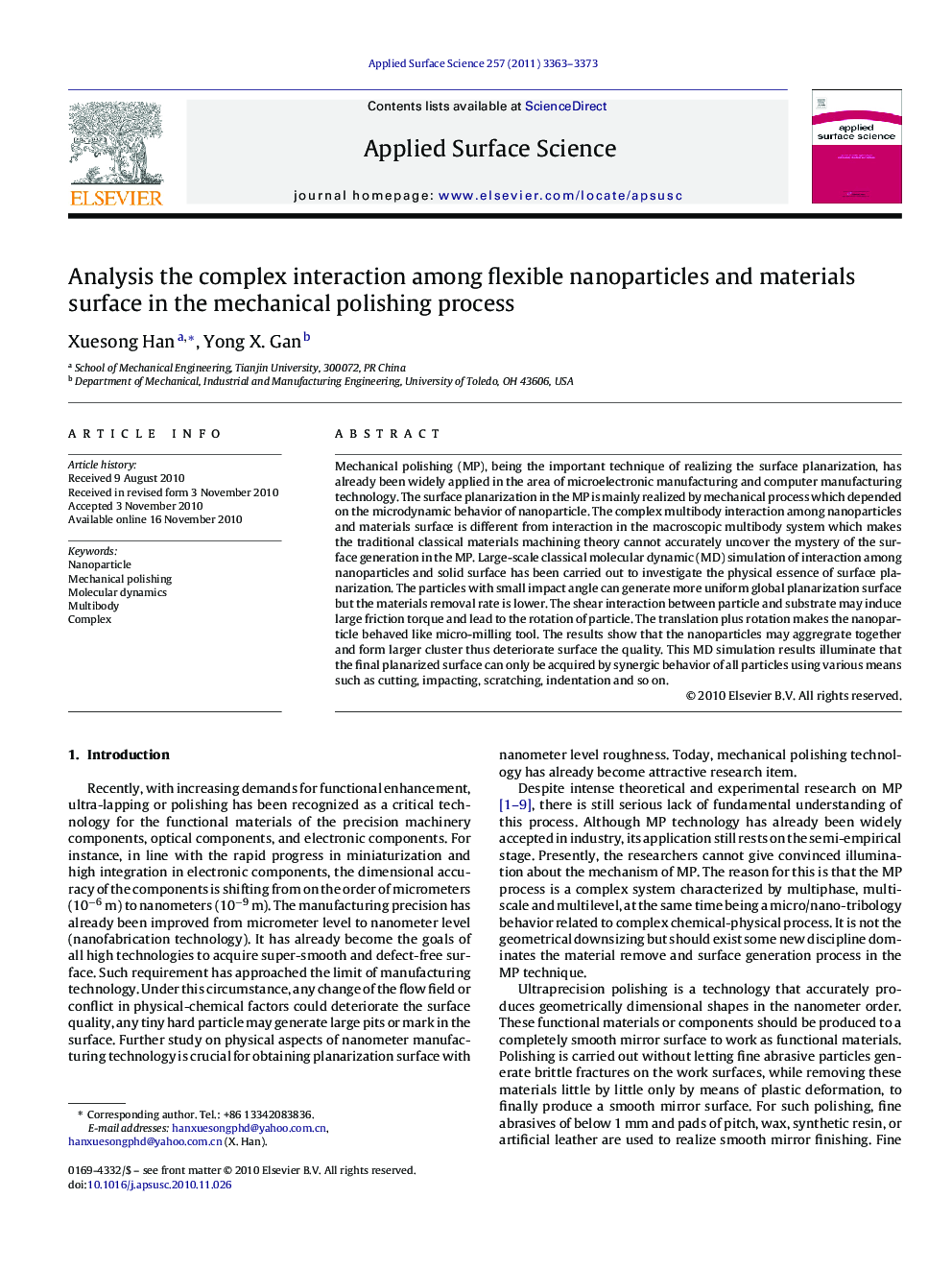| کد مقاله | کد نشریه | سال انتشار | مقاله انگلیسی | نسخه تمام متن |
|---|---|---|---|---|
| 5368049 | 1388383 | 2011 | 11 صفحه PDF | دانلود رایگان |

Mechanical polishing (MP), being the important technique of realizing the surface planarization, has already been widely applied in the area of microelectronic manufacturing and computer manufacturing technology. The surface planarization in the MP is mainly realized by mechanical process which depended on the microdynamic behavior of nanoparticle. The complex multibody interaction among nanoparticles and materials surface is different from interaction in the macroscopic multibody system which makes the traditional classical materials machining theory cannot accurately uncover the mystery of the surface generation in the MP. Large-scale classical molecular dynamic (MD) simulation of interaction among nanoparticles and solid surface has been carried out to investigate the physical essence of surface planarization. The particles with small impact angle can generate more uniform global planarization surface but the materials removal rate is lower. The shear interaction between particle and substrate may induce large friction torque and lead to the rotation of particle. The translation plus rotation makes the nanoparticle behaved like micro-milling tool. The results show that the nanoparticles may aggregrate together and form larger cluster thus deteriorate surface the quality. This MD simulation results illuminate that the final planarized surface can only be acquired by synergic behavior of all particles using various means such as cutting, impacting, scratching, indentation and so on.
Research highlightsⶠThe increasing demand for functional enhancement, ultra-lapping or polishing has been recognized as a critical technology for the functional materials of the precision machinery components, optical components, and electronic components. Further study on physical aspects of nanometer manufacturing technology is crucial for obtaining planarization surface whose roughness at the nanometer level. ⶠThe final surface integrity acquired using mechanical polishing (MP) technique is mainly depended on the microdynamic behavior of nanoparticles. The complex multibody interaction among nanoparticles and materials surface is different from interaction in the macroscopic scale which makes the traditional classical materials machining theory cannot accurately uncover the mystery of the surface generation in the MP. As the size of the particles decreases and approaches molecular dimensions, their atomic nature becomes increasingly important. A straightforward interpretation of experimental results is often not possible due to the complexity of the dynamics. The use of molecular dynamics (MD) simulation techniques has therefore become a very important tool in this field. ⶠThe polishing is a many body nanometer machining technology, and there exists complex interaction among particles as well as the interaction among particles and substrate materials. As this interaction falls into the nanometer regime, it is not downsizing but some new discipline and mechanism dominate the MP technology. Traditional continuum mechanics or experimental method cannot give reasonable explanation about this microscopic dynamic process. It is seems that only combining all kinds of particle actions and various characteristic polishing conditions can the physical essence of MP be discovered. Large-scale classical molecular dynamic (MD) simulation of interaction among nanoparticles and solid surface has been carried out to investigate the physical essence of surface planarization and drew some meaningful conclusions. ⶠThe particles with small impact angle can generate more uniform global planarization surface but the materials removal rate is lower. The shear interaction between particle and substrate may induce large friction torque and lead to the rotation of particle. The translation plus rotation makes the nanoparticle behaved like micro-milling tool. The results show that the nanoparticles may aggregrate together and form larger cluster thus deteriorate surface the quality. This MD simulation results illuminate that the final planarized surface can only be acquired by synergic behavior of all particles using various means such as cutting, impacting, scratching, indentation and so on.
Journal: Applied Surface Science - Volume 257, Issue 8, 1 February 2011, Pages 3363-3373